Lubrication Performance Promotion of GTL Base Oil by BN Nanosheets via Cascade Centrifugation-Assisted Liquid-Phase Exfoliation
Abstract
1. Introduction
2. Experimental Details
2.1. Materials
2.2. Preparation of GTL Base Oil with BNNS
2.3. Tribology Tests and Analysis
3. Results and Discussion
3.1. Characterization of BNNS
3.2. Friction and Wear Performance
3.3. Worn Surface Analysis
3.4. Lubrication Mechanism
4. Conclusions
- The characterization results of BNNS show that it has a lamellar structure with lateral dimensions ranging from 100 to 500 nm and thicknesses around 50 nm. Cascade centrifugation-assisted liquid-phase exfoliation demonstrates high efficiency, rapid processing, and excellent scalability for producing high-quality and impurity-free few-layer BNNSs from the boron nitride powders.
- Tribological tests revealed that BNNSs demonstrate excellent friction-reducing and anti-wear properties in GTL. Furthermore, the findings indicate that at a BNNS content of 0.8 wt.%, the system displayed the lowest COF and WSD. Particularly, with an addition of 0.8 wt.% BNNS into GTL, the AFC and WSD were reduced significantly by 40.1% and 35.4%, by comparison with pure base oil, respectively, and the surface roughness, wear depth, and wear volume were effectively reduced by 91.0%, 68.5%, and 76.8%, compared to GTL base oil, respectively.
- The Raman, SEM-EDS, and XPS results proved that the prominent friction-reducing and anti-wear properties of BNNS could primarily be ascribed to the presence of the physical adsorption film and tribo-chemical film, which were composed of FeOOH, FeO, Fe3O4, and B2O3.
Author Contributions
Funding
Data Availability Statement
Conflicts of Interest
References
- Liang, Z.; Wang, S.; Zhu, K.; Chen, Y.; Wei, F.; Chen, D. Enhancing the tribological properties and corrosion resistance of graphene-based lubricating grease via ultrasonic-assisted ball milling. Colloids Surf. A Physicochem. Eng. Asp. 2022, 633 Pt 2, 127889. [Google Scholar] [CrossRef]
- Cheng, Z.; Qin, X. Study on friction performance of graphene-based semi-solid grease. Chin. Chem. Lett. 2014, 25, 1305–1307. [Google Scholar] [CrossRef]
- Krylov, S.Y.; Frenken, J.W.M. Atomistic mechanisms for frictional energy dissipation during continuous sliding. Sci. Rep. 2021, 11, 19964. [Google Scholar] [CrossRef]
- Guan, J.; Xu, Z.; Zheng, L.; Yang, L.; Huang, S. Self-lubricating properties of polyether-ether-ketone composites filled with CNTs@RC2540 nano-capsules. Lubricants 2023, 11, 511. [Google Scholar] [CrossRef]
- Liu, X.; Wang, L.; Xue, Q. DLC-based solid–liquid synergetic lubricating coatings for improving tribological behavior of boundary lubricated surfaces under high vacuum condition. Wear 2011, 271, 889–898. [Google Scholar] [CrossRef]
- Zhang, X.; Xue, S.; Yan, Y.; Liu, S.; Ye, Q.; Zhou, F. Mechanochemical Synthesis of Thiadiazole Functionalized COF as Oil-Based Lubricant Additive for Reducing Friction and Wear. Langmuir 2024, 40, 4373–4381. [Google Scholar] [CrossRef] [PubMed]
- Jiang, Z.; Wu, J.; Yu, L.; Bi, J.; Wang, Y.; Hu, X.; Zhang, Y.; Li, W. Two-dimensional nanomaterials as lubricant additives: The state-of-the-art and future prospects. J. Mater. Chem. C 2025, 13, 4327–4373. [Google Scholar] [CrossRef]
- Yang, C.; Wang, G.; Guo, S.; Sun, J. Potential and progress of two-dimensional nanomaterials in oil-based lubrication. Chin. Chem. Lett. 2025, 111178. [Google Scholar] [CrossRef]
- Scherge, M.; Böttcher, R.; Kürten, D.; Linsler, D. Multi-Phase Friction and Wear Reduction by Copper Nanoparticles. Lubricants 2016, 4, 36. [Google Scholar] [CrossRef]
- He, X.; Stevenson, L.M.; Kumara, C.; Mathews, T.J.; Luo, H.; Qu, J. Comparison of eco-friendly ionic liquids and commercial bio-derived lubricant additives in terms of tribological performance and aquatic toxicity. Molecules 2024, 29, 3851. [Google Scholar] [CrossRef]
- Ankit, K.; Pranami, R.; Satyanarayana, G.R. Thermophysical and tribological properties of nanolubricants: A review. Heat Mass Transf. 2018, 54, 3493–3508. [Google Scholar]
- Alireza, F.; Vahab, G.; Fatemeh, A. The experimental comparison between the effect of copper oxide and graphene nanoparticles on rheological behavior and thermal properties of engine oil. Pet. Sci. Technol. 2022, 40, 803–821. [Google Scholar]
- Wang, Q.; Wang, L.; Zhao, S.; Meng, Z. Experimental study on the suspension stability and tribological properties of nano-copper in LCKD-320# lubricating oil. Appl. Nanosci. 2020, 11, 45–54. [Google Scholar]
- Xu, J.; Lu, H.; Lian, J. The influence of the particle size and size synergistic effect of nano-copper on the tribological properties of lubricants. Tribol. Int. 2025, 201, 110282. [Google Scholar] [CrossRef]
- Han, Y.; Pan, L.; Zhang, H.; Zeng, Y.; Yin, Z. Effect of lubricant additives of Cu, Fe and bimetallic CuFe nanoparticles on tribological properties. Wear 2022, 508, 204485. [Google Scholar] [CrossRef]
- Li, J.; Chen, D.; Zhang, H.; Jiang, Z.; Sun, K.; Fan, J.; Tang, Y. The tribological properties of nano-lubricants and their application on bearings: Recent research progress. Int. J. Adv. Manuf. Technol. 2024, 134, 3051–3082. [Google Scholar] [CrossRef]
- Li, T.; He, Y.; Zhang, C.; Xue, H.; Zhong, Y.; Gu, L.; Wu, L. Remarkable lubricity of CNTs microspheres as additives in oil lubricant for ceramic components. Ceram. Int. 2024, 50, 1411–1418. [Google Scholar] [CrossRef]
- Wang, W.; Zhang, G.; Xie, G. Ultralow concentration of graphene oxide nanosheets as oil-based lubricant additives. Appl. Surf. Sci. 2019, 498, 143683. [Google Scholar] [CrossRef]
- Shen, M.; Li, B.; Zhang, Z.; Zhao, L.; Xiong, G. Abrasive wear behavior of PTFE for seal applications under abrasive-atmosphere sliding condition. Friction 2019, 8, 755–767. [Google Scholar] [CrossRef]
- Martins, A.S.; Valdicleide, S.E.M.; Amilton, S. Nanolubrication Mechanisms: Influence of Size and Concentration of CuO Nanoparticles. Mater. Perform. Charact. 2018, 7, 226–241. [Google Scholar]
- Sun, W.; Zhou, Z.; Liu, J. The size effect of SiO2 particles on friction mechanisms of a composite friction material. Tribol. Lett. 2018, 66, 35. [Google Scholar] [CrossRef]
- Dong, S.; Wang, W.; Gao, Y.; Deng, G. Tribological properties of different-sized black phosphorus nanosheets as water-based lubrication additives for steel/titanium alloy wear contact. Metals 2022, 12, 288. [Google Scholar] [CrossRef]
- Shan, Z.; Jia, X.; Tian, R.; Yang, J.; Su, Y.; Song, H. In-situ exfoliation of large sized h-BNNS by esterified nanocellulose to build aqueous lubricants that can switch between liquid and gel states. Tribol. Int. 2023, 188, 108843. [Google Scholar] [CrossRef]
- Kumari, S.; Chouhan, A.; Sharma, O.P.; Tawfik, S.A.; Spencer, M.J.S.; Bhargava, S.K.; Walia, S.; Ray, A.; Khatri, O.P. Alkali-Assisted Hydrothermal Exfoliation and Surfactant-Driven Functionalization of h-BN Nanosheets for Lubrication Enhancement. ACS Appl. Nano Mater. 2021, 4, 9143–9154. [Google Scholar] [CrossRef]
- Yang, W.; Geng, Z.; Li, Y.; Liu, X.; Tian, X.; Wang, S.; Wu, N.; Wang, Y.; Xu, R.; Yang, F.; et al. Facile synthesis of lipophilic alkylated boron nitride nanosheets as lubricating oil additive to greatly enhance the friction and heat-conducting properties. Tribol. Int. 2022, 173, 107655. [Google Scholar] [CrossRef]
- Kumar, N.; Saini, V.; Bijwe, J. Tribological investigations of nano and micro-sized graphite particles as an additive in lithium-based grease. Tribol. Lett. 2020, 68, 124. [Google Scholar] [CrossRef]
- Zhang, B.; Wu, Q.; Yu, H.; Bulin, C.; Sun, H.; Li, R.; Ge, X.; Xing, R. High-efficient liquid exfoliation of boron nitride nanosheets using aqueous solution of alkanolamine. Nanoscale Res. Lett. 2017, 12, 596. [Google Scholar] [CrossRef]
- Qin, Y.; Wu, M.; Yang, G.; Yang, Y.; Zhao, L. Tribological performance of magnesium silicate hydroxide/Ni composite as an oil-based additive for steel–steel contact. Tribol. Lett. 2021, 69, 19. [Google Scholar] [CrossRef]
- Yuan, F.; Jiao, W.; Yang, F.; Liu, W.; Liu, J.; Xu, Z.; Wang, R. Scalable exfoliation for large-size boron nitride nanosheets by low temperature thermal expansion-assisted ultrasonic exfoliation. J. Mater. Chem. C 2017, 5, 6359–6368. [Google Scholar] [CrossRef]
- Shan, Q.; Shi, X.; Wang, X.; Wu, W. Preparation of functionalized boron nitride nanosheets by high-gravity liquid phase exfoliation technology. Chem. Eng. Process.-Process Intensif. 2021, 169, 108602. [Google Scholar] [CrossRef]
- Zhu, J.; Lu, Z.; Aruna, S.T.; Doron, A.; Aharon, G. Sonochemical synthesis of SnO2 nanoparticles and their preliminary study as Li insertion electrodes. Chem. Mater. 2000, 12, 2557–2566. [Google Scholar] [CrossRef]
- Shang, J.; Xue, F.; Fan, C.; Ding, E. Preparation of few layers hexagonal boron nitride nanosheets via high-pressure homogenization. Mater. Lett. 2016, 181, 144–147. [Google Scholar] [CrossRef]
- Lin, K.; Zhuang, Z.; Li, Y.; Zeng, Z.; Wei, X.; Fan, X.; Zhu, M. Well-dispersed graphene enhanced lithium complex grease toward high-efficient lubrication. Chin. J. Mech. Eng. 2023, 36, 133. [Google Scholar] [CrossRef]
- Jiang, H.; Hou, X.; Qian, Y.; Liu, H.; Kamal, A.A.M.; Dearn, K.D. A tribological behavior assessment of steel contacting interface lubricated by engine oil introducing layered structural nanomaterials functionalized by oleic acid. Wear 2023, 524, 204675. [Google Scholar] [CrossRef]
- Du, C.; Yu, T.; Wu, Z.; Zhang, L.; Shen, R.; Li, X.; Feng, M.; Feng, Y.; Wang, D. Achieving macroscale superlubricity with ultra-short running-in period by using polyethylene glycol-tannic acid complex green lubricant. Friction 2023, 11, 748–762. [Google Scholar] [CrossRef]
- Chen, H.; Xiao, G.; Chen, Z.; Yi, M.; Zhang, J.; Li, Z.; Xu, C. Hexagonal boron nitride (h-BN) nanosheets as lubricant additive to 5CB liquid crystal for friction and wear reduction. Mater. Lett. 2022, 307, 131007. [Google Scholar] [CrossRef]
- Liu, L.; Jiao, S.; Peng, Y.; Zhou, W. A Green Design for Lubrication: Multifunctional System Containing Fe3O4@MoS2 Nanohybrid. ACS Sustain. Chem. Eng. 2018, 6, 7372–7379. [Google Scholar] [CrossRef]
- Lei, X.; Zhang, Y.; Zhang, S.; Yang, G.; Zhang, C.; Zhang, P. Study on the mechanism of rapid formation of ultra-thick tribofilm by CeO2 nano additive and ZDDP. Friction 2022, 11, 48–63. [Google Scholar] [CrossRef]
- Zhao, Y.; Luo, C.; Zhang, J.; Zhang, X.; Wang, F.; Bai, C. A strategy of hexagonal boron nitride endowing lubricant oil with steady superlubricity. Appl. Surf. Sci. 2025, 697, 163060. [Google Scholar] [CrossRef]
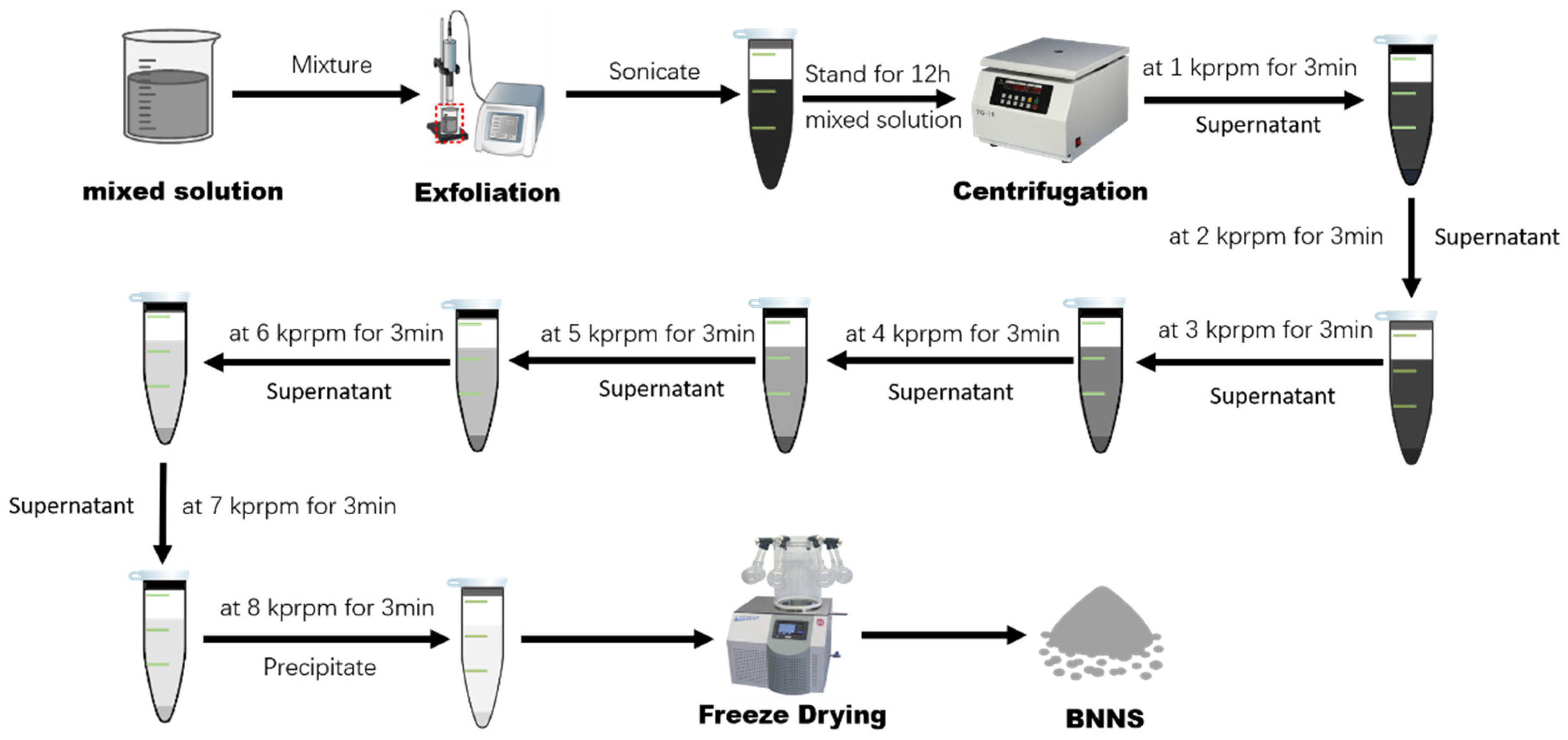
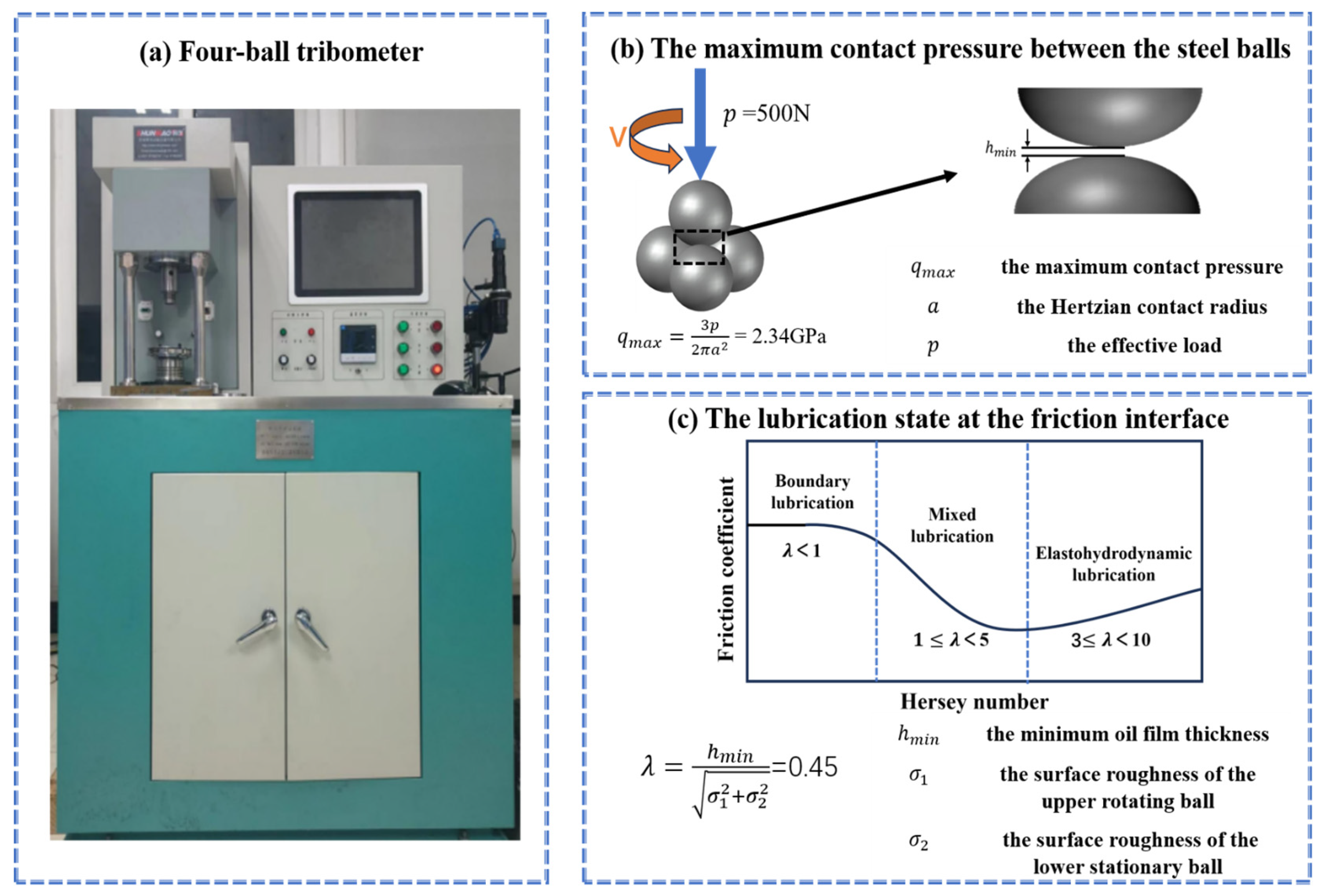
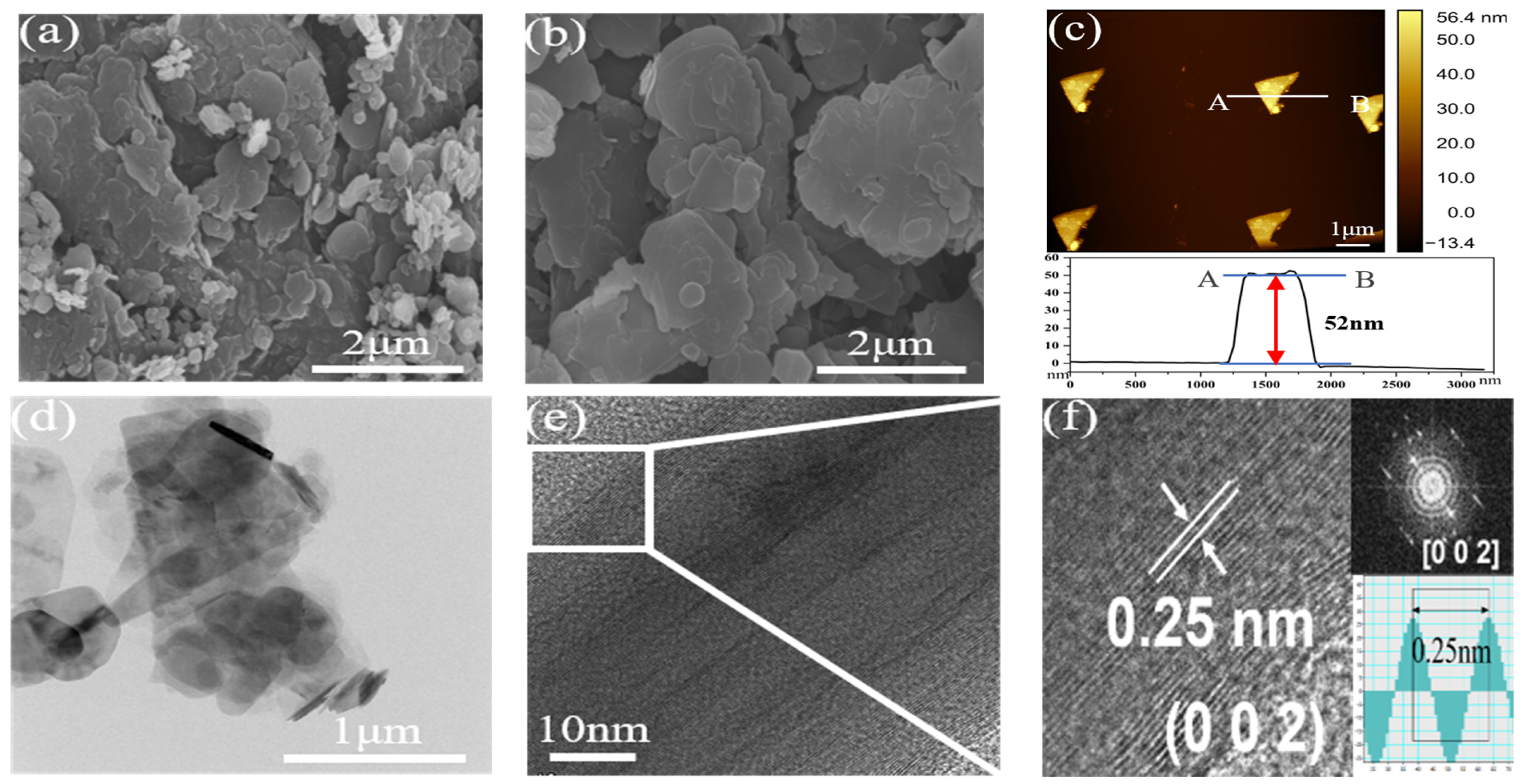

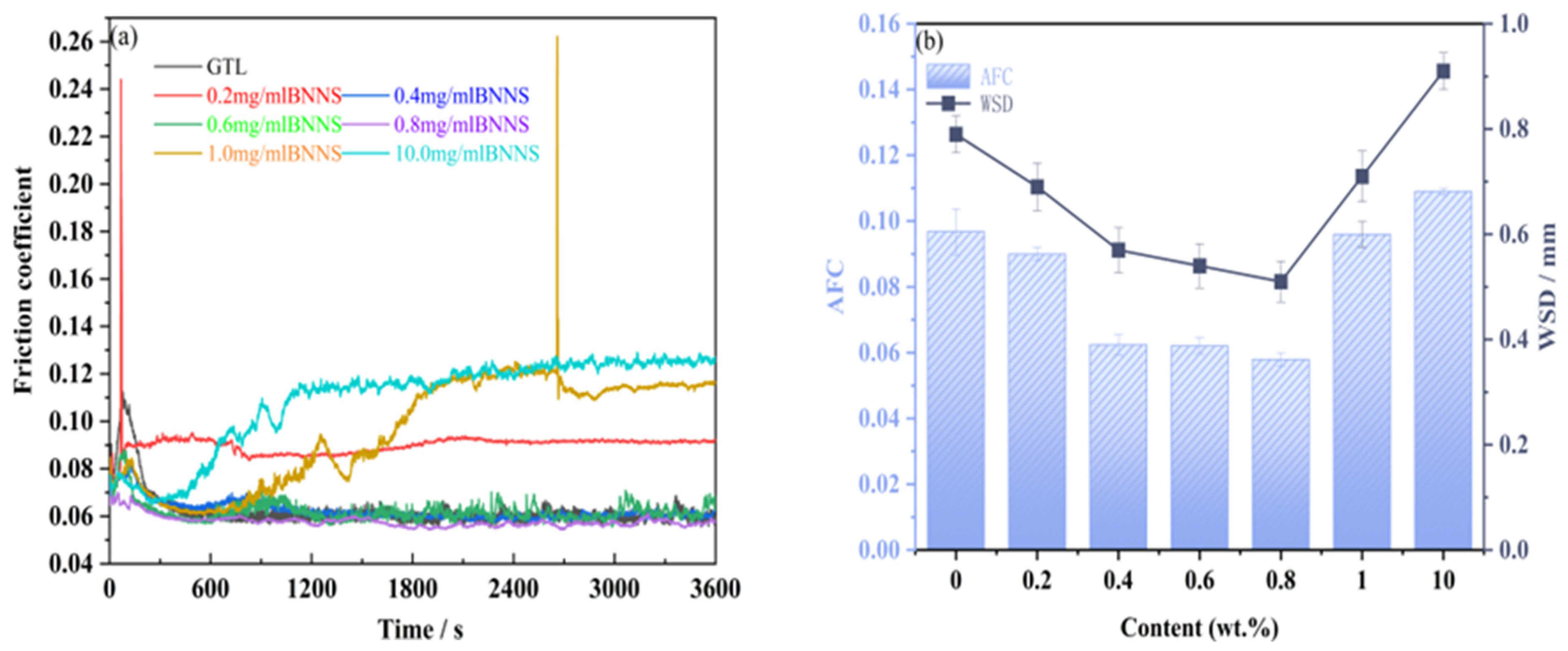
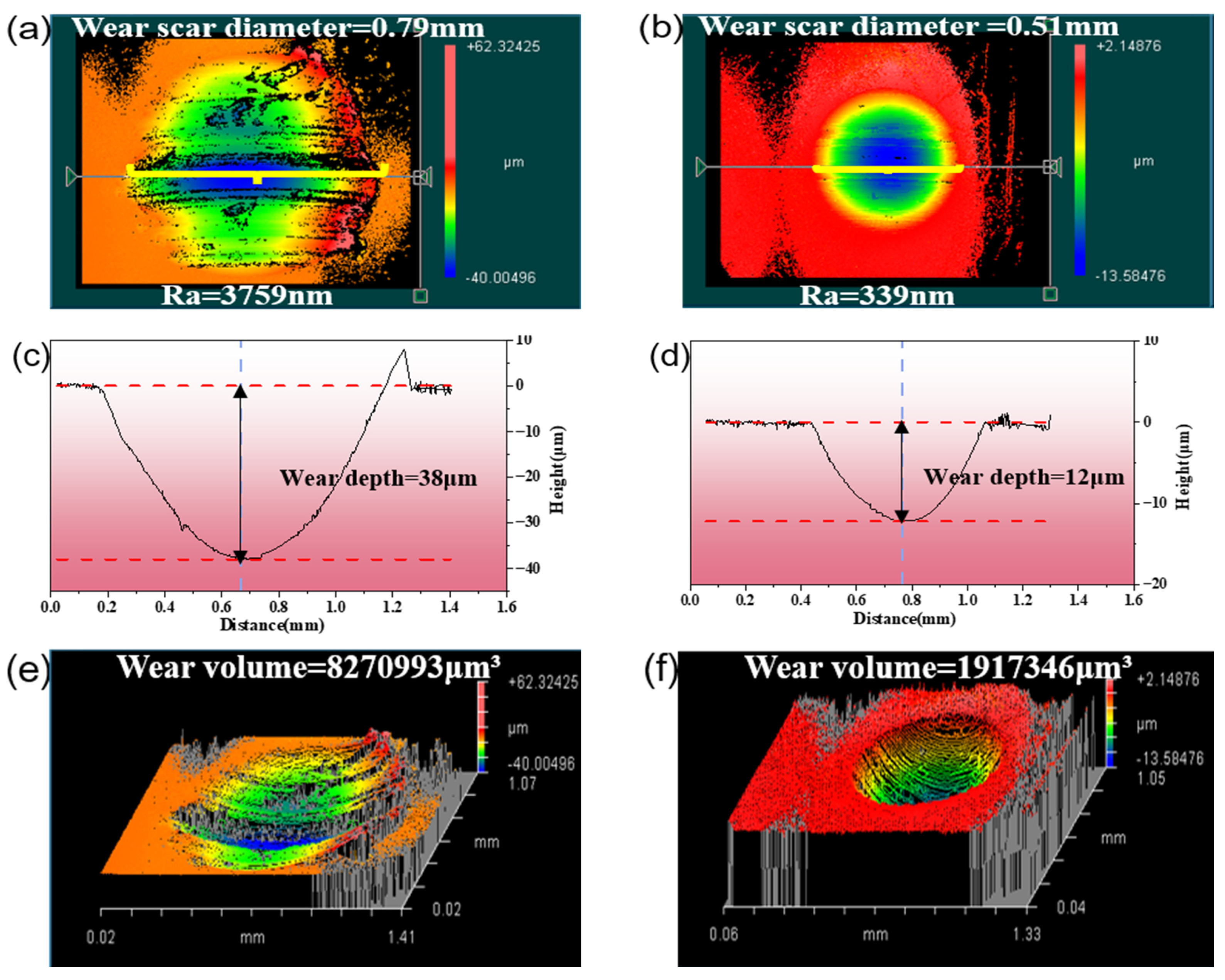
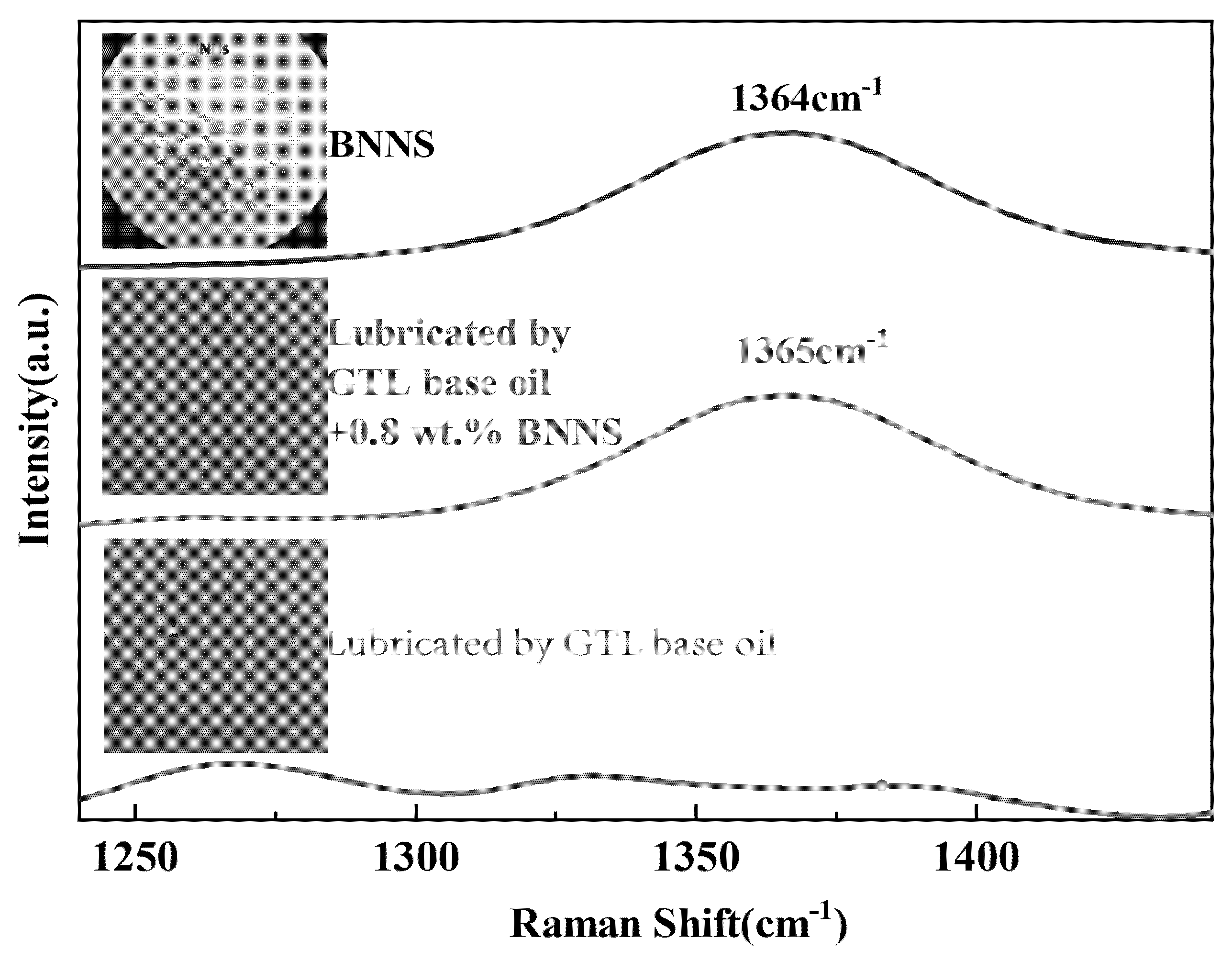

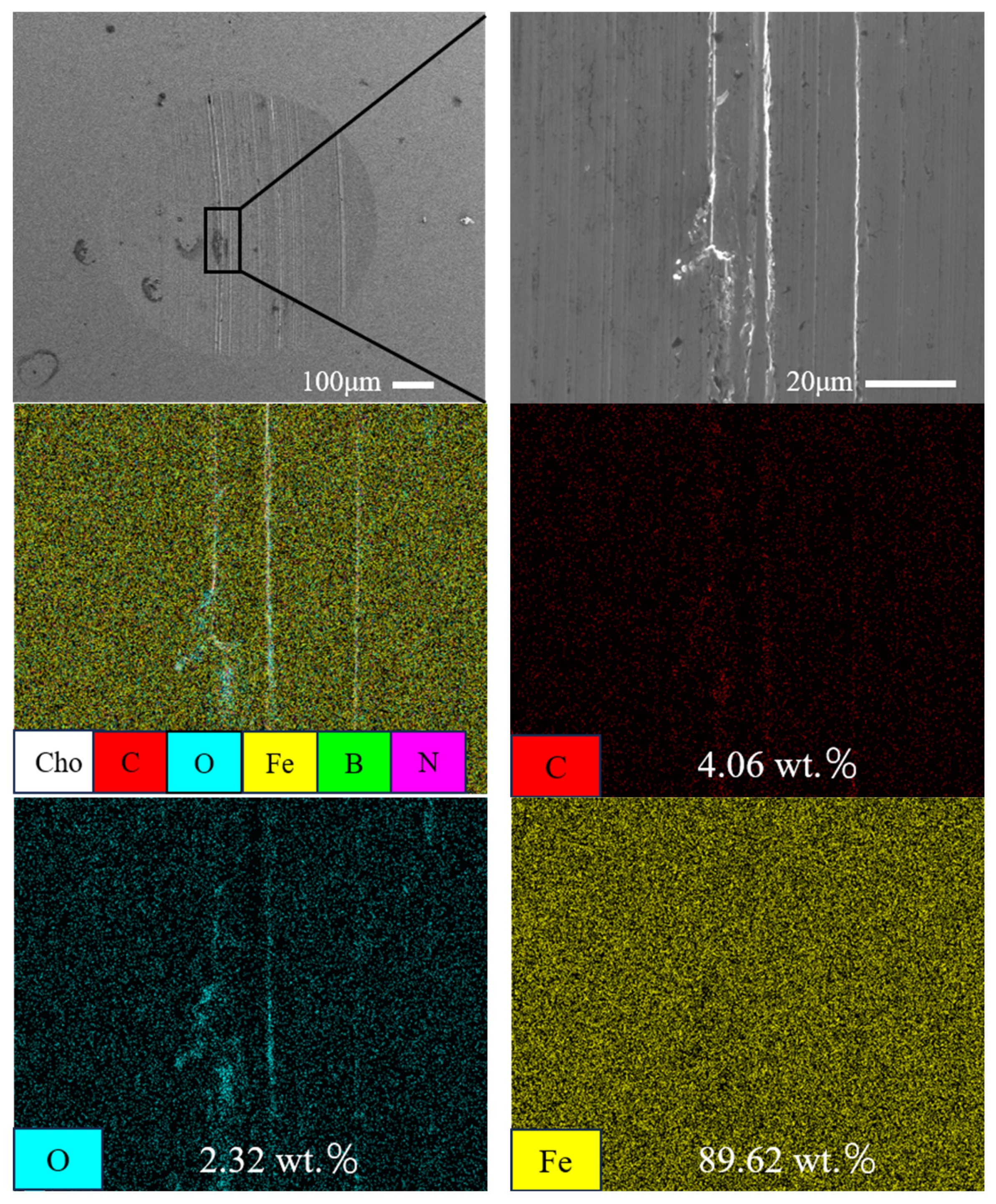
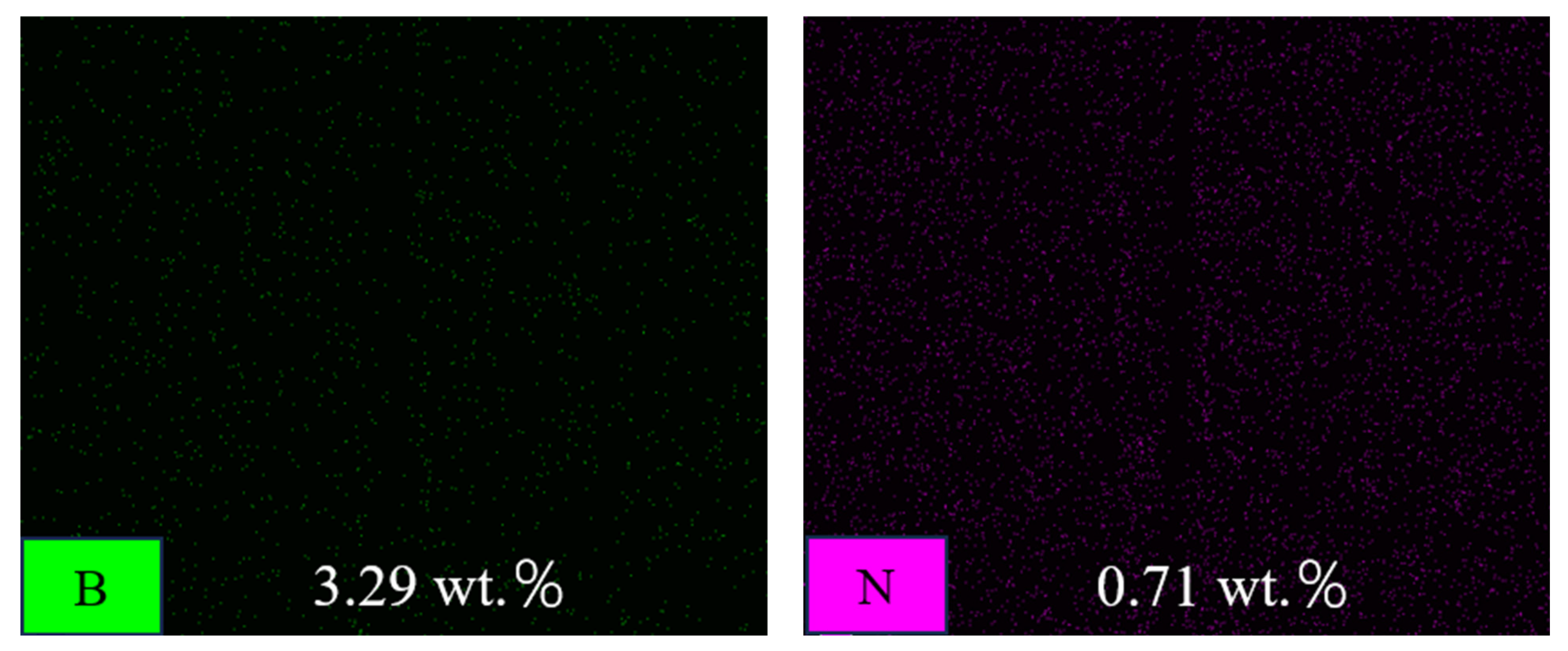

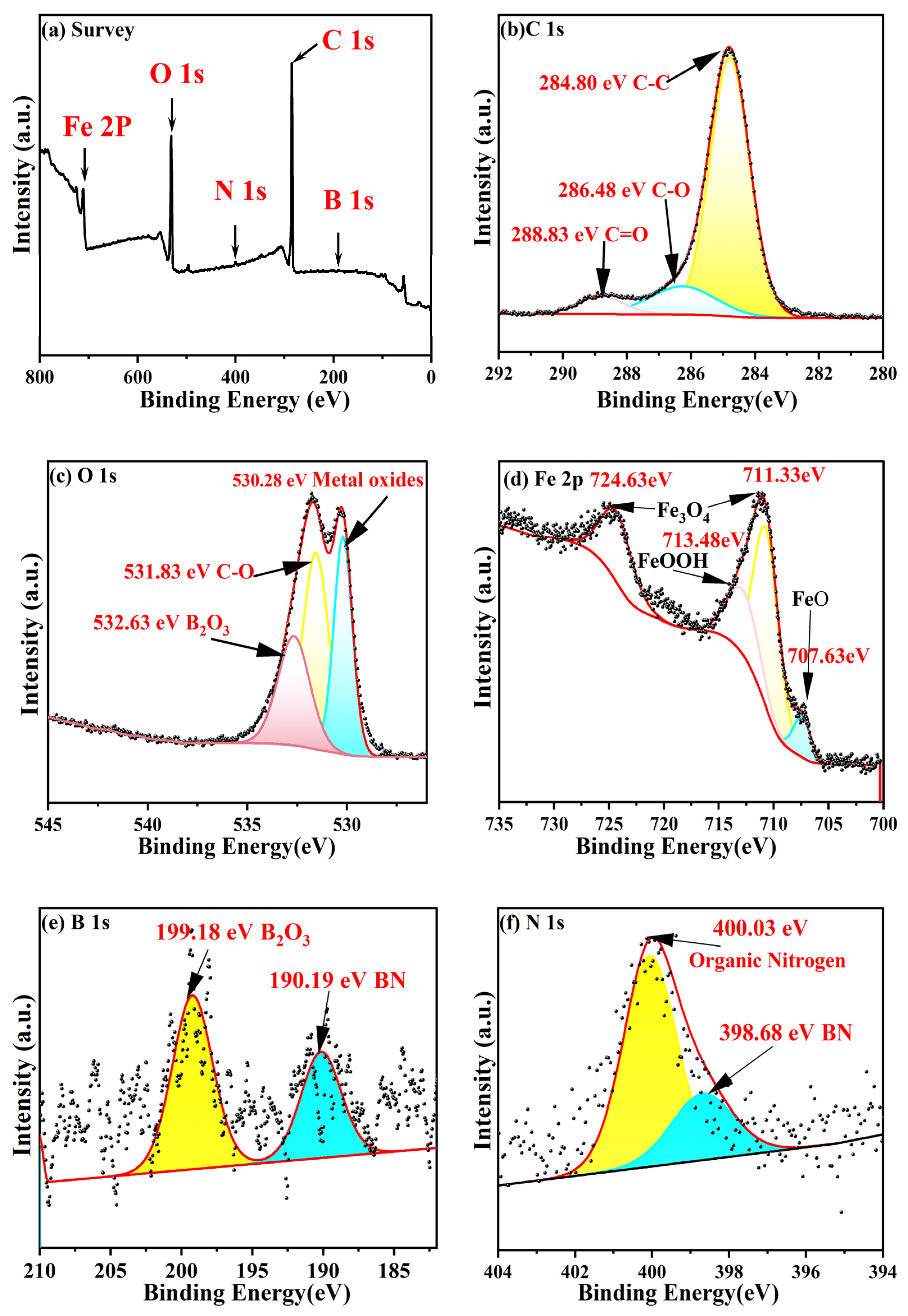
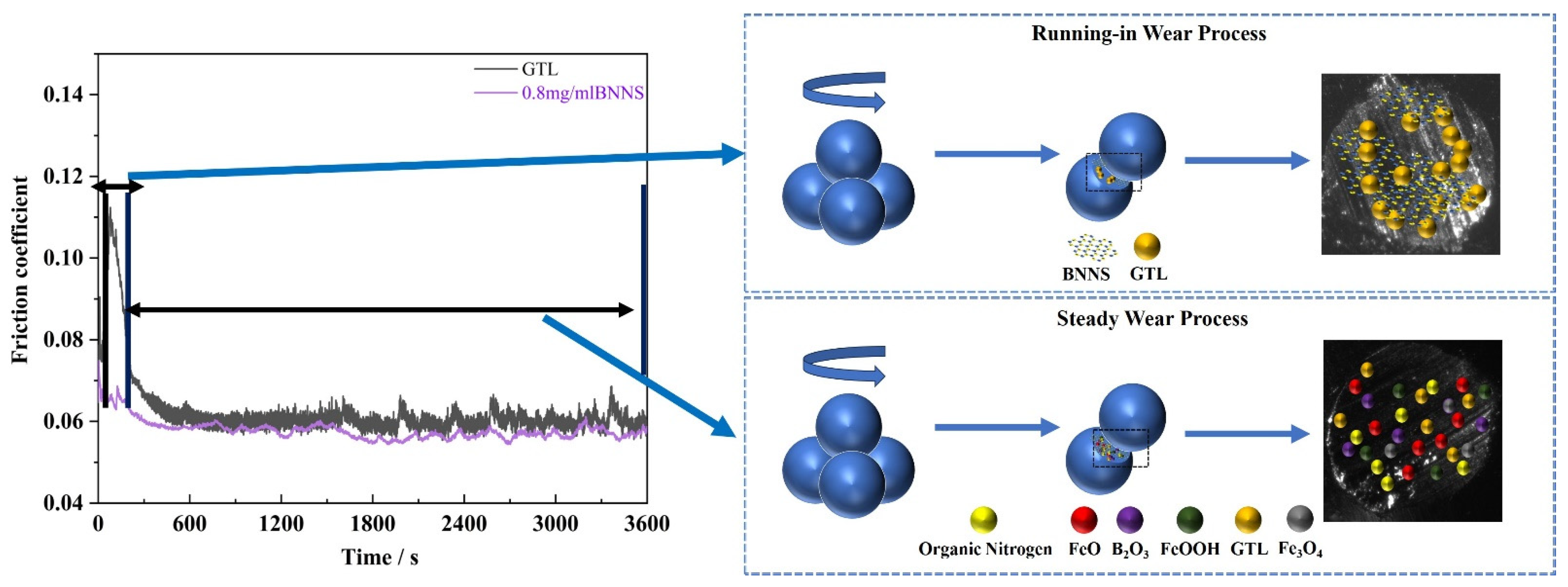
| Test Description | Result | Method |
|---|---|---|
| Kinematic viscosity (mm2/s) (40 °C) | 44.23 | ASTM D445 |
| Kinematic viscosity (mm2/s) (100 °C) | 7.615 | ASTM D445 |
| Viscosity Index | 140 | ASTM D2270 |
| Appearance | Clear to bright | Visual |
| Color (ASTM) (Quantitative) | 0.5 | ASTM D1500 |
| Color (Seibert color) | 30 | ASTM D156 |
| Density (kg/m3) (15 °C) | 827.7 | ASTM D4052 |
| Refractive index (20 °C) | 1.46 | ASTM D1218 |
| Pour point (°C) | −45 | ASTM D6749 |
| Flash point (°C) (PMcc) | 234 | ASTM D93 |
| Parameter | GTL Base Oil | 0.2 wt.% BNNS | 0.4 wt.% BNNS | 0.6 wt.% BNNS | 0.8 wt.% BNNS | 1.0 wt.% BNNS | 10.0 wt.% BNNS |
|---|---|---|---|---|---|---|---|
| Speed | 1200 r/min | ||||||
| Load | 500 N | ||||||
| Temperature | 40 °C | ||||||
| Test Duration | 60 min | ||||||
| Component | Elastic modulus | Poisson ratio | Diameter | Rockwell | Surface roughness | ||
| GCr15 | 2.085 × 105 Mpa | 0.3 | 12.7 mm | 60 ± 1 | 0.256 µm | ||
Disclaimer/Publisher’s Note: The statements, opinions and data contained in all publications are solely those of the individual author(s) and contributor(s) and not of MDPI and/or the editor(s). MDPI and/or the editor(s) disclaim responsibility for any injury to people or property resulting from any ideas, methods, instructions or products referred to in the content. |
© 2025 by the authors. Licensee MDPI, Basel, Switzerland. This article is an open access article distributed under the terms and conditions of the Creative Commons Attribution (CC BY) license (https://creativecommons.org/licenses/by/4.0/).
Share and Cite
Liu, J.; Xiang, S.; Zhou, X.; Lin, S.; Dong, K.; Liu, Y.; He, D.; Fan, Y.; Liu, Y.; Xiong, B.; et al. Lubrication Performance Promotion of GTL Base Oil by BN Nanosheets via Cascade Centrifugation-Assisted Liquid-Phase Exfoliation. Lubricants 2025, 13, 281. https://doi.org/10.3390/lubricants13070281
Liu J, Xiang S, Zhou X, Lin S, Dong K, Liu Y, He D, Fan Y, Liu Y, Xiong B, et al. Lubrication Performance Promotion of GTL Base Oil by BN Nanosheets via Cascade Centrifugation-Assisted Liquid-Phase Exfoliation. Lubricants. 2025; 13(7):281. https://doi.org/10.3390/lubricants13070281
Chicago/Turabian StyleLiu, Jiashun, Shuo Xiang, Xiaoyu Zhou, Shigang Lin, Kehong Dong, Yiwei Liu, Donghai He, Yunhong Fan, Yuehao Liu, Bingxue Xiong, and et al. 2025. "Lubrication Performance Promotion of GTL Base Oil by BN Nanosheets via Cascade Centrifugation-Assisted Liquid-Phase Exfoliation" Lubricants 13, no. 7: 281. https://doi.org/10.3390/lubricants13070281
APA StyleLiu, J., Xiang, S., Zhou, X., Lin, S., Dong, K., Liu, Y., He, D., Fan, Y., Liu, Y., Xiong, B., Ma, K., Xiao, K., Luo, G., Zhang, Q., & Yang, X. (2025). Lubrication Performance Promotion of GTL Base Oil by BN Nanosheets via Cascade Centrifugation-Assisted Liquid-Phase Exfoliation. Lubricants, 13(7), 281. https://doi.org/10.3390/lubricants13070281





